Business Process Management
VerifiedAdded on 2023/01/13
|13
|2000
|89
AI Summary
This document provides an overview of Business Process Management (BPM) and Business Process Reengineering (BPR), including their benefits and shortcomings. It also explores the foundations of BPMN and provides examples of intermediate BPMN models. Additionally, it includes a section on calculating competitive offers in BPM.
Contribute Materials
Your contribution can guide someone’s learning journey. Share your
documents today.
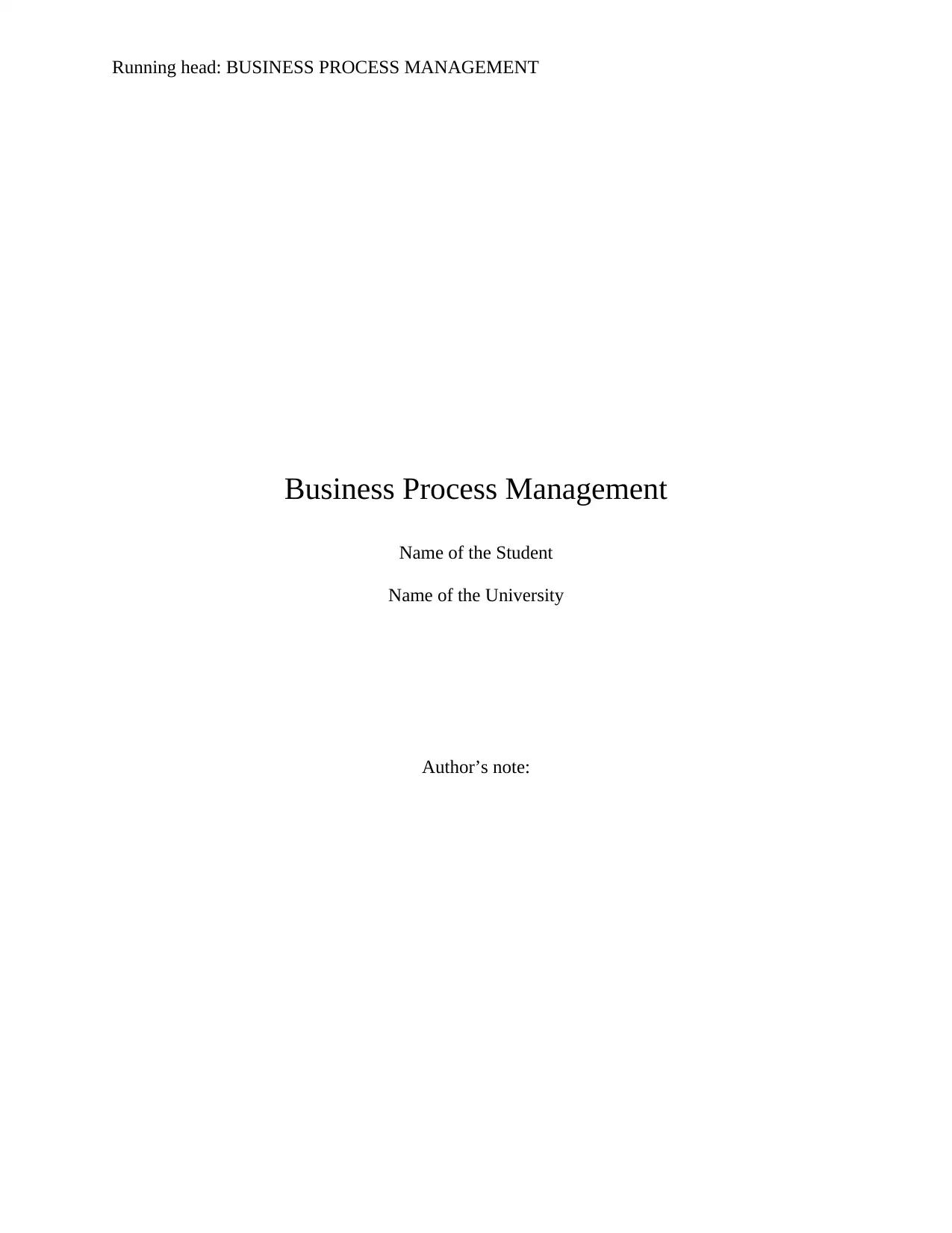
Running head: BUSINESS PROCESS MANAGEMENT
Business Process Management
Name of the Student
Name of the University
Author’s note:
Business Process Management
Name of the Student
Name of the University
Author’s note:
Secure Best Marks with AI Grader
Need help grading? Try our AI Grader for instant feedback on your assignments.

1BUSINESS PROCESS MANAGEMENT
Table of Contents
1. Introduction to Business Process Management:..........................................................................2
1.a Benefits and Shortcomings:...................................................................................................2
1.a.1 Business Process Management:......................................................................................2
1.a.2 Business Process Reengineering:....................................................................................2
1.b BPM vs BPR Lifecycle:.........................................................................................................3
1.c Combining BPM and BPR:....................................................................................................4
2. Foundations of BPMN:................................................................................................................4
3. Intermediate BPMN:....................................................................................................................6
3.1 Explaining BPMN Model:.....................................................................................................6
3.2 BPMN Model Review:..........................................................................................................6
3.3 BPMN Models:......................................................................................................................9
3.3.A Scenario 1:.....................................................................................................................9
3.3.B Scenario 2:......................................................................................................................9
3.4 Calculating Competitive Offer:...........................................................................................10
Bibliography:.................................................................................................................................12
Table of Contents
1. Introduction to Business Process Management:..........................................................................2
1.a Benefits and Shortcomings:...................................................................................................2
1.a.1 Business Process Management:......................................................................................2
1.a.2 Business Process Reengineering:....................................................................................2
1.b BPM vs BPR Lifecycle:.........................................................................................................3
1.c Combining BPM and BPR:....................................................................................................4
2. Foundations of BPMN:................................................................................................................4
3. Intermediate BPMN:....................................................................................................................6
3.1 Explaining BPMN Model:.....................................................................................................6
3.2 BPMN Model Review:..........................................................................................................6
3.3 BPMN Models:......................................................................................................................9
3.3.A Scenario 1:.....................................................................................................................9
3.3.B Scenario 2:......................................................................................................................9
3.4 Calculating Competitive Offer:...........................................................................................10
Bibliography:.................................................................................................................................12
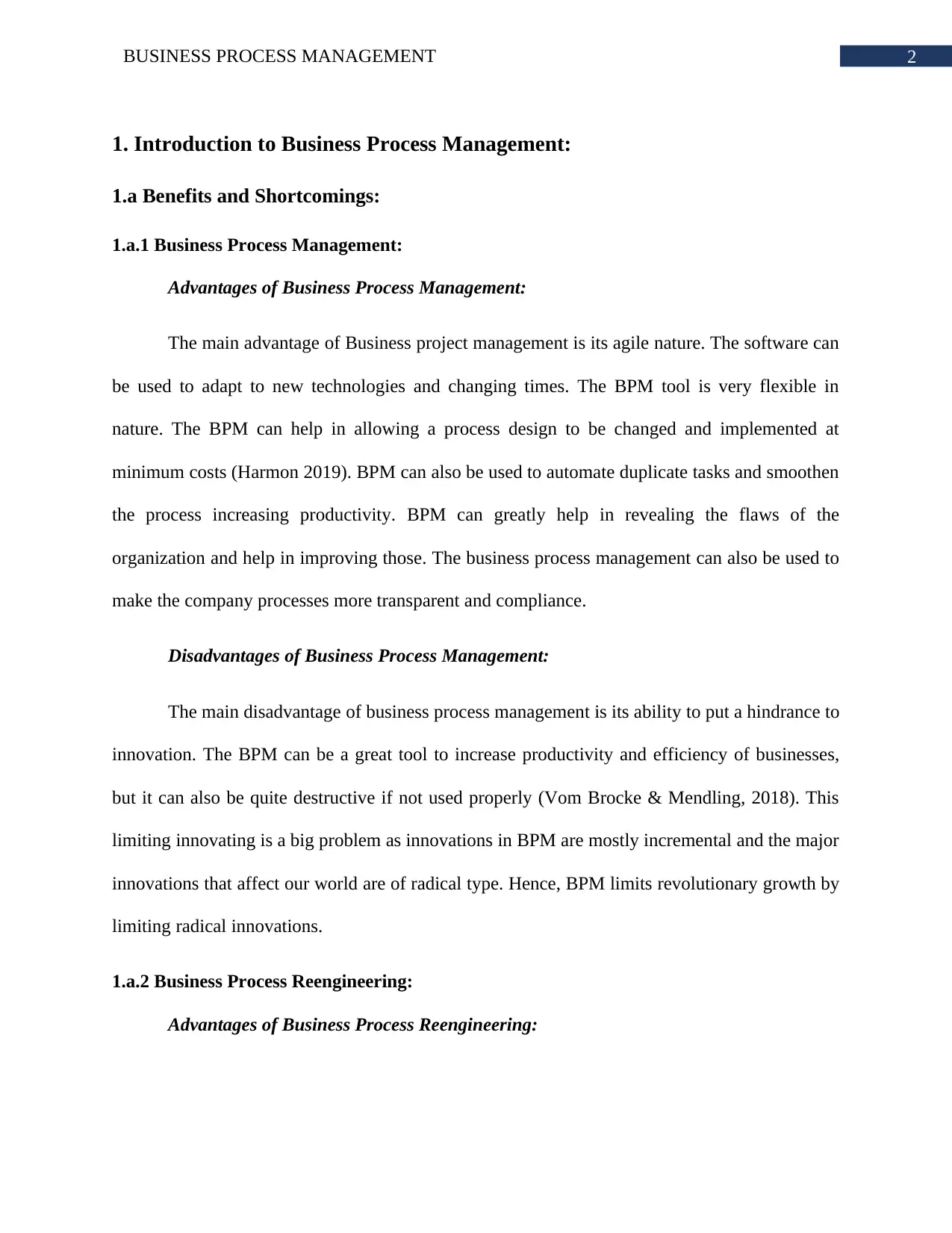
2BUSINESS PROCESS MANAGEMENT
1. Introduction to Business Process Management:
1.a Benefits and Shortcomings:
1.a.1 Business Process Management:
Advantages of Business Process Management:
The main advantage of Business project management is its agile nature. The software can
be used to adapt to new technologies and changing times. The BPM tool is very flexible in
nature. The BPM can help in allowing a process design to be changed and implemented at
minimum costs (Harmon 2019). BPM can also be used to automate duplicate tasks and smoothen
the process increasing productivity. BPM can greatly help in revealing the flaws of the
organization and help in improving those. The business process management can also be used to
make the company processes more transparent and compliance.
Disadvantages of Business Process Management:
The main disadvantage of business process management is its ability to put a hindrance to
innovation. The BPM can be a great tool to increase productivity and efficiency of businesses,
but it can also be quite destructive if not used properly (Vom Brocke & Mendling, 2018). This
limiting innovating is a big problem as innovations in BPM are mostly incremental and the major
innovations that affect our world are of radical type. Hence, BPM limits revolutionary growth by
limiting radical innovations.
1.a.2 Business Process Reengineering:
Advantages of Business Process Reengineering:
1. Introduction to Business Process Management:
1.a Benefits and Shortcomings:
1.a.1 Business Process Management:
Advantages of Business Process Management:
The main advantage of Business project management is its agile nature. The software can
be used to adapt to new technologies and changing times. The BPM tool is very flexible in
nature. The BPM can help in allowing a process design to be changed and implemented at
minimum costs (Harmon 2019). BPM can also be used to automate duplicate tasks and smoothen
the process increasing productivity. BPM can greatly help in revealing the flaws of the
organization and help in improving those. The business process management can also be used to
make the company processes more transparent and compliance.
Disadvantages of Business Process Management:
The main disadvantage of business process management is its ability to put a hindrance to
innovation. The BPM can be a great tool to increase productivity and efficiency of businesses,
but it can also be quite destructive if not used properly (Vom Brocke & Mendling, 2018). This
limiting innovating is a big problem as innovations in BPM are mostly incremental and the major
innovations that affect our world are of radical type. Hence, BPM limits revolutionary growth by
limiting radical innovations.
1.a.2 Business Process Reengineering:
Advantages of Business Process Reengineering:
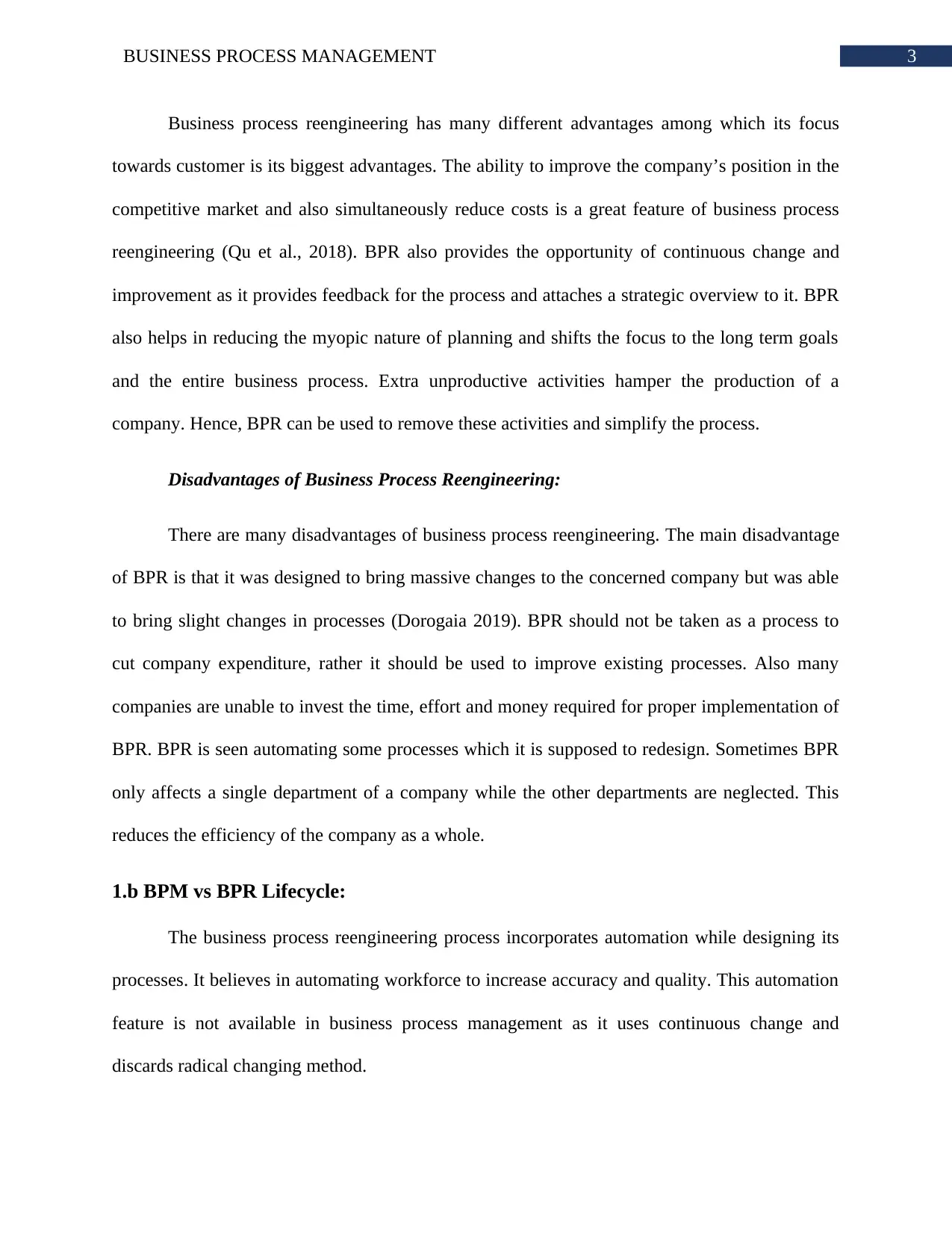
3BUSINESS PROCESS MANAGEMENT
Business process reengineering has many different advantages among which its focus
towards customer is its biggest advantages. The ability to improve the company’s position in the
competitive market and also simultaneously reduce costs is a great feature of business process
reengineering (Qu et al., 2018). BPR also provides the opportunity of continuous change and
improvement as it provides feedback for the process and attaches a strategic overview to it. BPR
also helps in reducing the myopic nature of planning and shifts the focus to the long term goals
and the entire business process. Extra unproductive activities hamper the production of a
company. Hence, BPR can be used to remove these activities and simplify the process.
Disadvantages of Business Process Reengineering:
There are many disadvantages of business process reengineering. The main disadvantage
of BPR is that it was designed to bring massive changes to the concerned company but was able
to bring slight changes in processes (Dorogaia 2019). BPR should not be taken as a process to
cut company expenditure, rather it should be used to improve existing processes. Also many
companies are unable to invest the time, effort and money required for proper implementation of
BPR. BPR is seen automating some processes which it is supposed to redesign. Sometimes BPR
only affects a single department of a company while the other departments are neglected. This
reduces the efficiency of the company as a whole.
1.b BPM vs BPR Lifecycle:
The business process reengineering process incorporates automation while designing its
processes. It believes in automating workforce to increase accuracy and quality. This automation
feature is not available in business process management as it uses continuous change and
discards radical changing method.
Business process reengineering has many different advantages among which its focus
towards customer is its biggest advantages. The ability to improve the company’s position in the
competitive market and also simultaneously reduce costs is a great feature of business process
reengineering (Qu et al., 2018). BPR also provides the opportunity of continuous change and
improvement as it provides feedback for the process and attaches a strategic overview to it. BPR
also helps in reducing the myopic nature of planning and shifts the focus to the long term goals
and the entire business process. Extra unproductive activities hamper the production of a
company. Hence, BPR can be used to remove these activities and simplify the process.
Disadvantages of Business Process Reengineering:
There are many disadvantages of business process reengineering. The main disadvantage
of BPR is that it was designed to bring massive changes to the concerned company but was able
to bring slight changes in processes (Dorogaia 2019). BPR should not be taken as a process to
cut company expenditure, rather it should be used to improve existing processes. Also many
companies are unable to invest the time, effort and money required for proper implementation of
BPR. BPR is seen automating some processes which it is supposed to redesign. Sometimes BPR
only affects a single department of a company while the other departments are neglected. This
reduces the efficiency of the company as a whole.
1.b BPM vs BPR Lifecycle:
The business process reengineering process incorporates automation while designing its
processes. It believes in automating workforce to increase accuracy and quality. This automation
feature is not available in business process management as it uses continuous change and
discards radical changing method.
Secure Best Marks with AI Grader
Need help grading? Try our AI Grader for instant feedback on your assignments.
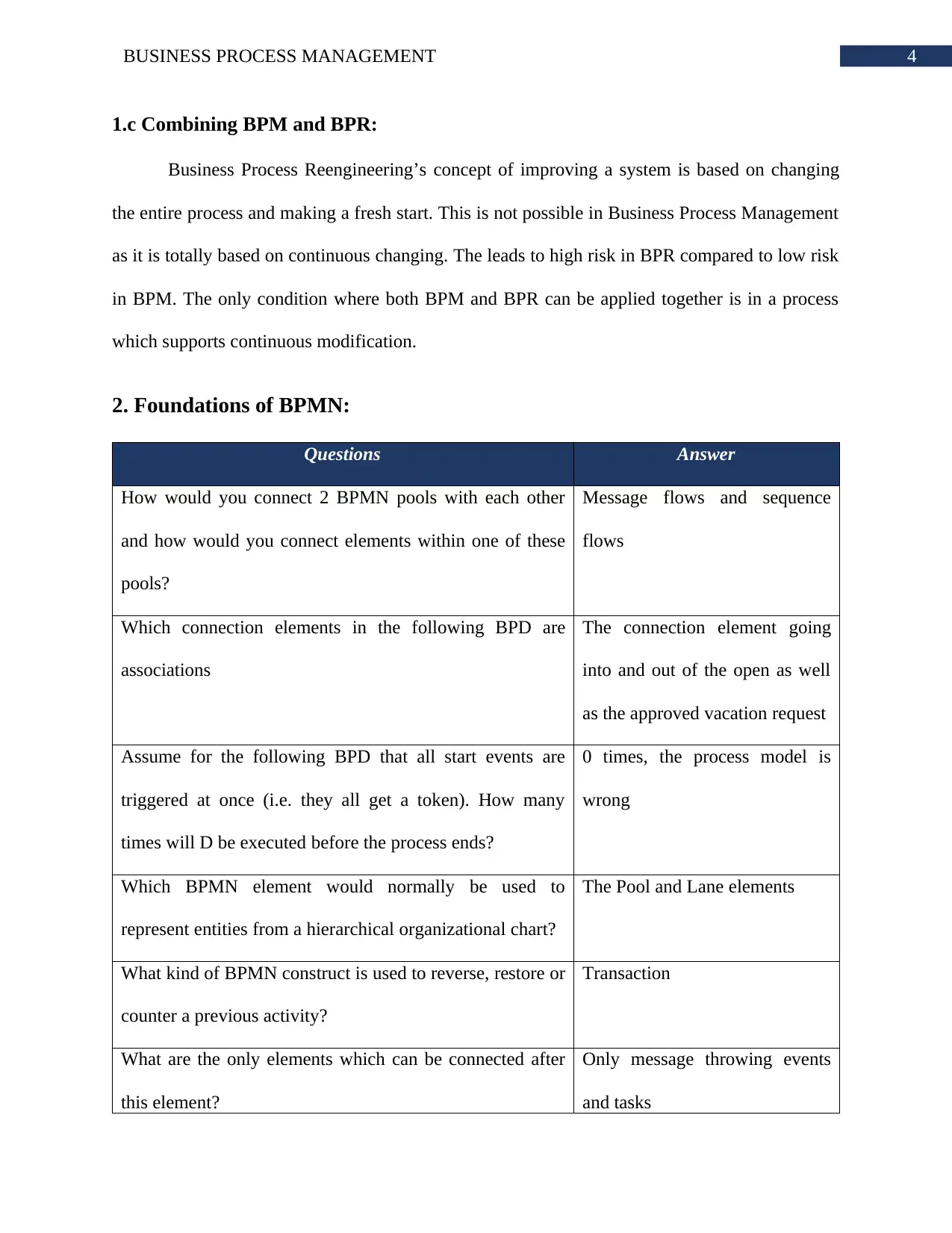
4BUSINESS PROCESS MANAGEMENT
1.c Combining BPM and BPR:
Business Process Reengineering’s concept of improving a system is based on changing
the entire process and making a fresh start. This is not possible in Business Process Management
as it is totally based on continuous changing. The leads to high risk in BPR compared to low risk
in BPM. The only condition where both BPM and BPR can be applied together is in a process
which supports continuous modification.
2. Foundations of BPMN:
Questions Answer
How would you connect 2 BPMN pools with each other
and how would you connect elements within one of these
pools?
Message flows and sequence
flows
Which connection elements in the following BPD are
associations
The connection element going
into and out of the open as well
as the approved vacation request
Assume for the following BPD that all start events are
triggered at once (i.e. they all get a token). How many
times will D be executed before the process ends?
0 times, the process model is
wrong
Which BPMN element would normally be used to
represent entities from a hierarchical organizational chart?
The Pool and Lane elements
What kind of BPMN construct is used to reverse, restore or
counter a previous activity?
Transaction
What are the only elements which can be connected after
this element?
Only message throwing events
and tasks
1.c Combining BPM and BPR:
Business Process Reengineering’s concept of improving a system is based on changing
the entire process and making a fresh start. This is not possible in Business Process Management
as it is totally based on continuous changing. The leads to high risk in BPR compared to low risk
in BPM. The only condition where both BPM and BPR can be applied together is in a process
which supports continuous modification.
2. Foundations of BPMN:
Questions Answer
How would you connect 2 BPMN pools with each other
and how would you connect elements within one of these
pools?
Message flows and sequence
flows
Which connection elements in the following BPD are
associations
The connection element going
into and out of the open as well
as the approved vacation request
Assume for the following BPD that all start events are
triggered at once (i.e. they all get a token). How many
times will D be executed before the process ends?
0 times, the process model is
wrong
Which BPMN element would normally be used to
represent entities from a hierarchical organizational chart?
The Pool and Lane elements
What kind of BPMN construct is used to reverse, restore or
counter a previous activity?
Transaction
What are the only elements which can be connected after
this element?
Only message throwing events
and tasks
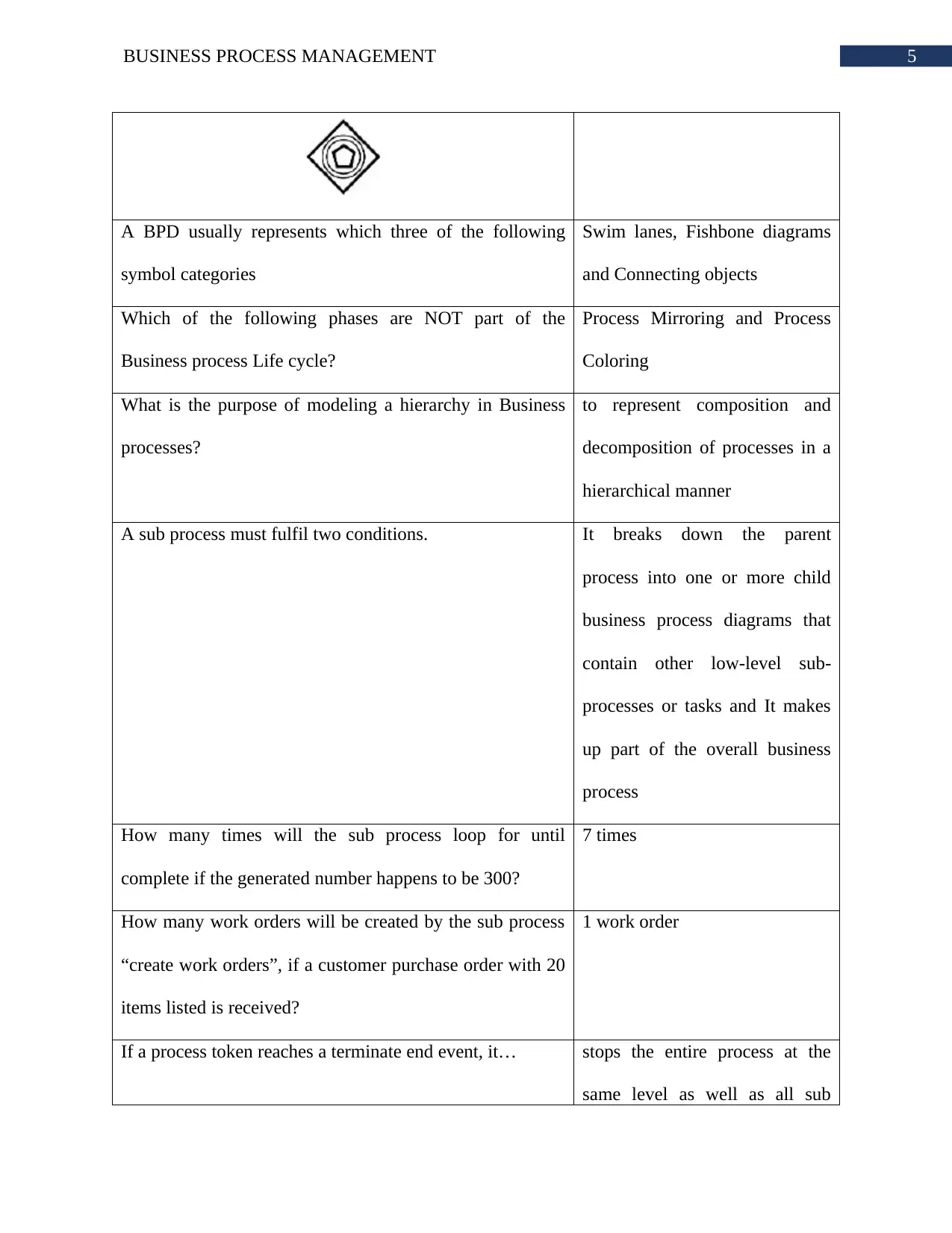
5BUSINESS PROCESS MANAGEMENT
A BPD usually represents which three of the following
symbol categories
Swim lanes, Fishbone diagrams
and Connecting objects
Which of the following phases are NOT part of the
Business process Life cycle?
Process Mirroring and Process
Coloring
What is the purpose of modeling a hierarchy in Business
processes?
to represent composition and
decomposition of processes in a
hierarchical manner
A sub process must fulfil two conditions. It breaks down the parent
process into one or more child
business process diagrams that
contain other low-level sub-
processes or tasks and It makes
up part of the overall business
process
How many times will the sub process loop for until
complete if the generated number happens to be 300?
7 times
How many work orders will be created by the sub process
“create work orders”, if a customer purchase order with 20
items listed is received?
1 work order
If a process token reaches a terminate end event, it… stops the entire process at the
same level as well as all sub
A BPD usually represents which three of the following
symbol categories
Swim lanes, Fishbone diagrams
and Connecting objects
Which of the following phases are NOT part of the
Business process Life cycle?
Process Mirroring and Process
Coloring
What is the purpose of modeling a hierarchy in Business
processes?
to represent composition and
decomposition of processes in a
hierarchical manner
A sub process must fulfil two conditions. It breaks down the parent
process into one or more child
business process diagrams that
contain other low-level sub-
processes or tasks and It makes
up part of the overall business
process
How many times will the sub process loop for until
complete if the generated number happens to be 300?
7 times
How many work orders will be created by the sub process
“create work orders”, if a customer purchase order with 20
items listed is received?
1 work order
If a process token reaches a terminate end event, it… stops the entire process at the
same level as well as all sub
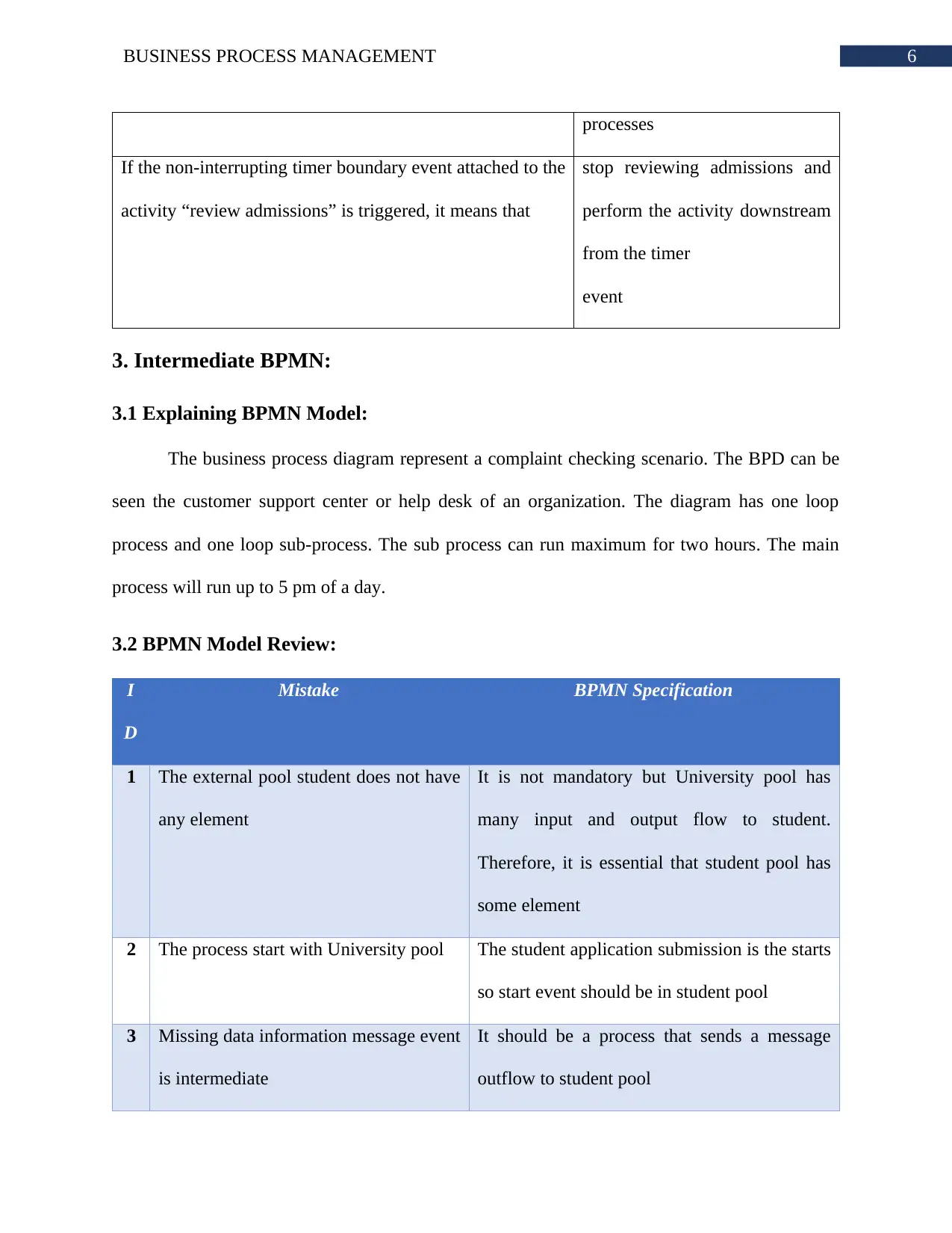
6BUSINESS PROCESS MANAGEMENT
processes
If the non-interrupting timer boundary event attached to the
activity “review admissions” is triggered, it means that
stop reviewing admissions and
perform the activity downstream
from the timer
event
3. Intermediate BPMN:
3.1 Explaining BPMN Model:
The business process diagram represent a complaint checking scenario. The BPD can be
seen the customer support center or help desk of an organization. The diagram has one loop
process and one loop sub-process. The sub process can run maximum for two hours. The main
process will run up to 5 pm of a day.
3.2 BPMN Model Review:
I
D
Mistake BPMN Specification
1 The external pool student does not have
any element
It is not mandatory but University pool has
many input and output flow to student.
Therefore, it is essential that student pool has
some element
2 The process start with University pool The student application submission is the starts
so start event should be in student pool
3 Missing data information message event
is intermediate
It should be a process that sends a message
outflow to student pool
processes
If the non-interrupting timer boundary event attached to the
activity “review admissions” is triggered, it means that
stop reviewing admissions and
perform the activity downstream
from the timer
event
3. Intermediate BPMN:
3.1 Explaining BPMN Model:
The business process diagram represent a complaint checking scenario. The BPD can be
seen the customer support center or help desk of an organization. The diagram has one loop
process and one loop sub-process. The sub process can run maximum for two hours. The main
process will run up to 5 pm of a day.
3.2 BPMN Model Review:
I
D
Mistake BPMN Specification
1 The external pool student does not have
any element
It is not mandatory but University pool has
many input and output flow to student.
Therefore, it is essential that student pool has
some element
2 The process start with University pool The student application submission is the starts
so start event should be in student pool
3 Missing data information message event
is intermediate
It should be a process that sends a message
outflow to student pool
Paraphrase This Document
Need a fresh take? Get an instant paraphrase of this document with our AI Paraphraser
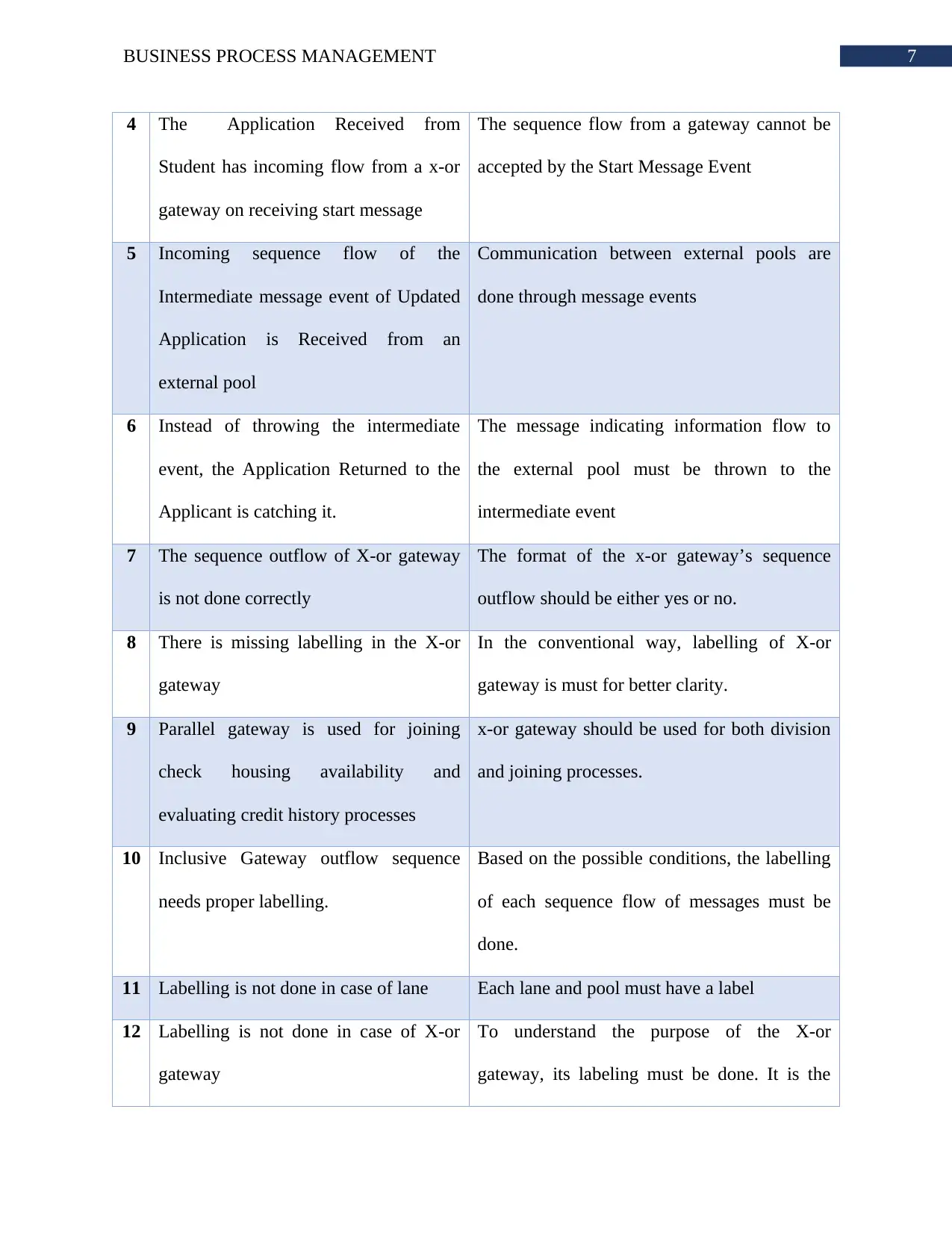
7BUSINESS PROCESS MANAGEMENT
4 The Application Received from
Student has incoming flow from a x-or
gateway on receiving start message
The sequence flow from a gateway cannot be
accepted by the Start Message Event
5 Incoming sequence flow of the
Intermediate message event of Updated
Application is Received from an
external pool
Communication between external pools are
done through message events
6 Instead of throwing the intermediate
event, the Application Returned to the
Applicant is catching it.
The message indicating information flow to
the external pool must be thrown to the
intermediate event
7 The sequence outflow of X-or gateway
is not done correctly
The format of the x-or gateway’s sequence
outflow should be either yes or no.
8 There is missing labelling in the X-or
gateway
In the conventional way, labelling of X-or
gateway is must for better clarity.
9 Parallel gateway is used for joining
check housing availability and
evaluating credit history processes
x-or gateway should be used for both division
and joining processes.
10 Inclusive Gateway outflow sequence
needs proper labelling.
Based on the possible conditions, the labelling
of each sequence flow of messages must be
done.
11 Labelling is not done in case of lane Each lane and pool must have a label
12 Labelling is not done in case of X-or
gateway
To understand the purpose of the X-or
gateway, its labeling must be done. It is the
4 The Application Received from
Student has incoming flow from a x-or
gateway on receiving start message
The sequence flow from a gateway cannot be
accepted by the Start Message Event
5 Incoming sequence flow of the
Intermediate message event of Updated
Application is Received from an
external pool
Communication between external pools are
done through message events
6 Instead of throwing the intermediate
event, the Application Returned to the
Applicant is catching it.
The message indicating information flow to
the external pool must be thrown to the
intermediate event
7 The sequence outflow of X-or gateway
is not done correctly
The format of the x-or gateway’s sequence
outflow should be either yes or no.
8 There is missing labelling in the X-or
gateway
In the conventional way, labelling of X-or
gateway is must for better clarity.
9 Parallel gateway is used for joining
check housing availability and
evaluating credit history processes
x-or gateway should be used for both division
and joining processes.
10 Inclusive Gateway outflow sequence
needs proper labelling.
Based on the possible conditions, the labelling
of each sequence flow of messages must be
done.
11 Labelling is not done in case of lane Each lane and pool must have a label
12 Labelling is not done in case of X-or
gateway
To understand the purpose of the X-or
gateway, its labeling must be done. It is the
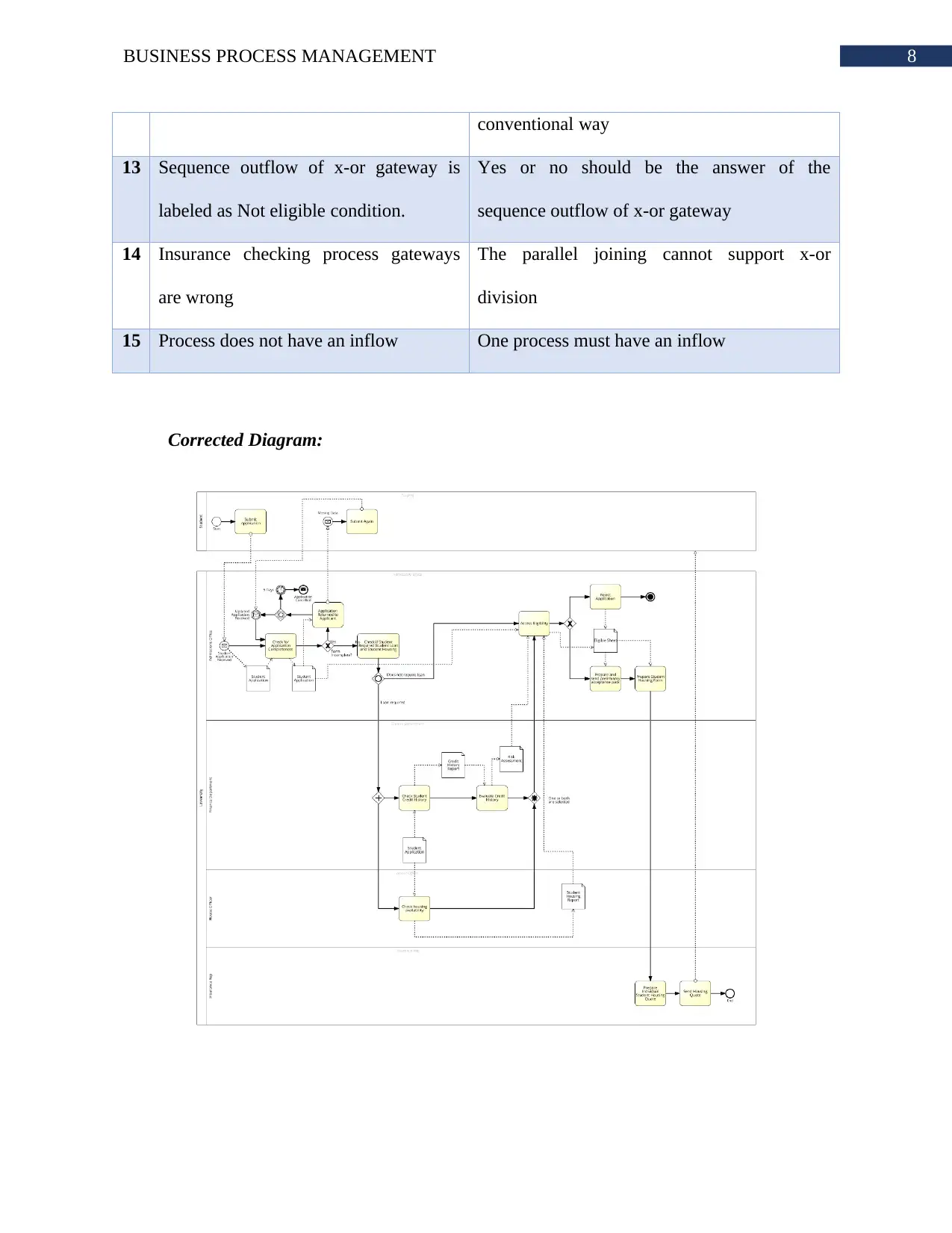
8BUSINESS PROCESS MANAGEMENT
conventional way
13 Sequence outflow of x-or gateway is
labeled as Not eligible condition.
Yes or no should be the answer of the
sequence outflow of x-or gateway
14 Insurance checking process gateways
are wrong
The parallel joining cannot support x-or
division
15 Process does not have an inflow One process must have an inflow
Corrected Diagram:
conventional way
13 Sequence outflow of x-or gateway is
labeled as Not eligible condition.
Yes or no should be the answer of the
sequence outflow of x-or gateway
14 Insurance checking process gateways
are wrong
The parallel joining cannot support x-or
division
15 Process does not have an inflow One process must have an inflow
Corrected Diagram:
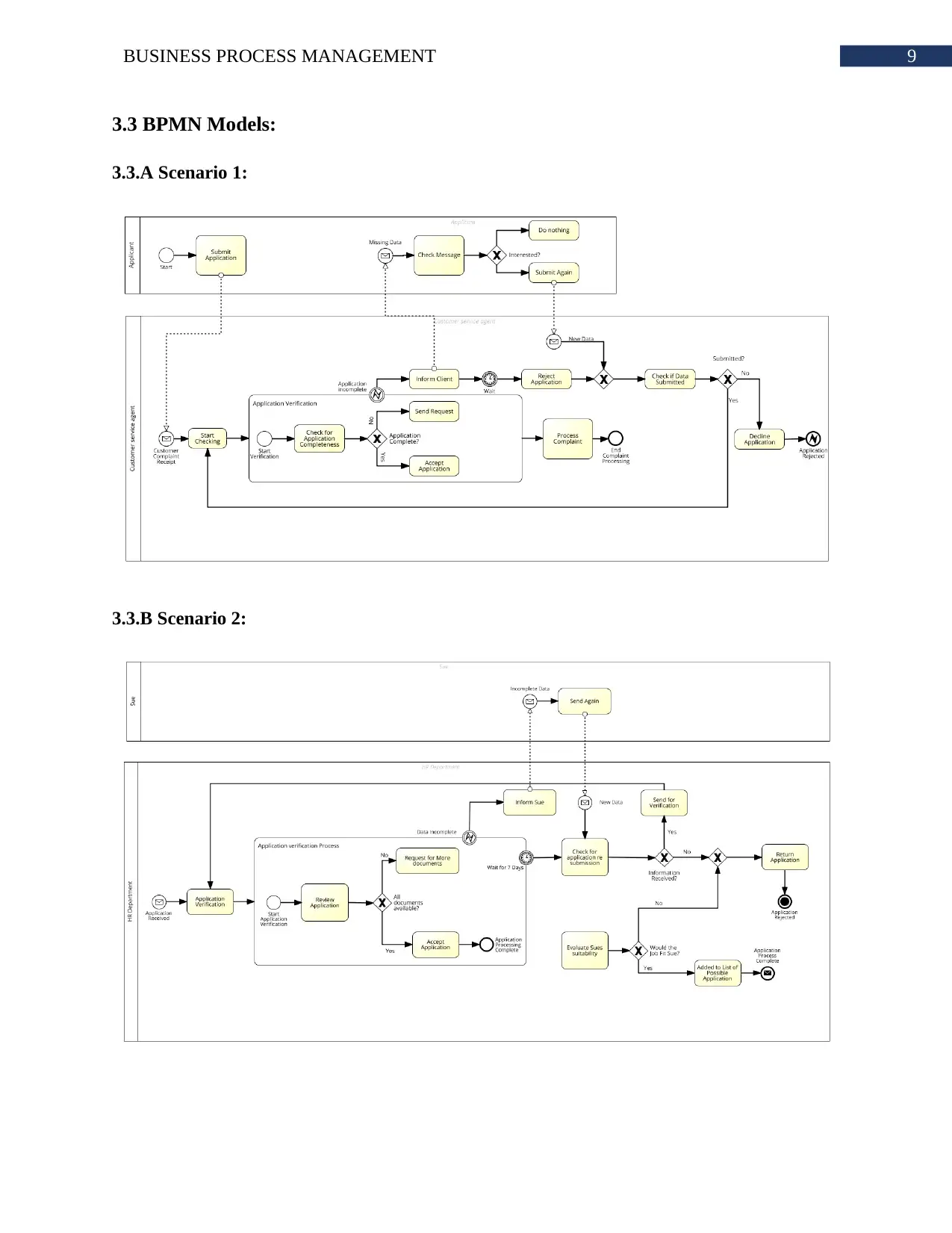
9BUSINESS PROCESS MANAGEMENT
3.3 BPMN Models:
3.3.A Scenario 1:
3.3.B Scenario 2:
3.3 BPMN Models:
3.3.A Scenario 1:
3.3.B Scenario 2:
Secure Best Marks with AI Grader
Need help grading? Try our AI Grader for instant feedback on your assignments.
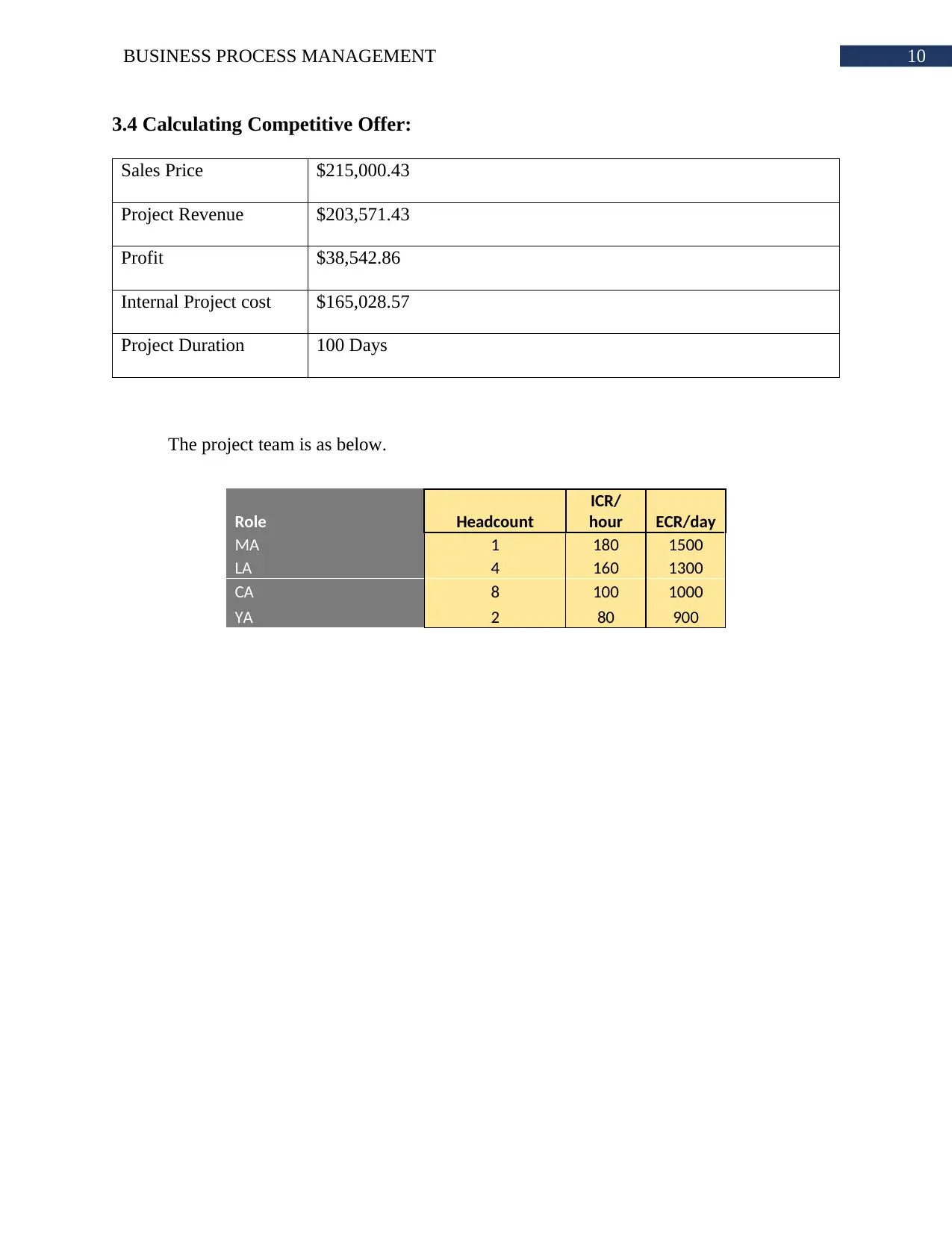
10BUSINESS PROCESS MANAGEMENT
3.4 Calculating Competitive Offer:
Sales Price $215,000.43
Project Revenue $203,571.43
Profit $38,542.86
Internal Project cost $165,028.57
Project Duration 100 Days
The project team is as below.
Role Headcount
ICR/
hour ECR/day
MA 1 180 1500
LA 4 160 1300
CA 8 100 1000
YA 2 80 900
3.4 Calculating Competitive Offer:
Sales Price $215,000.43
Project Revenue $203,571.43
Profit $38,542.86
Internal Project cost $165,028.57
Project Duration 100 Days
The project team is as below.
Role Headcount
ICR/
hour ECR/day
MA 1 180 1500
LA 4 160 1300
CA 8 100 1000
YA 2 80 900
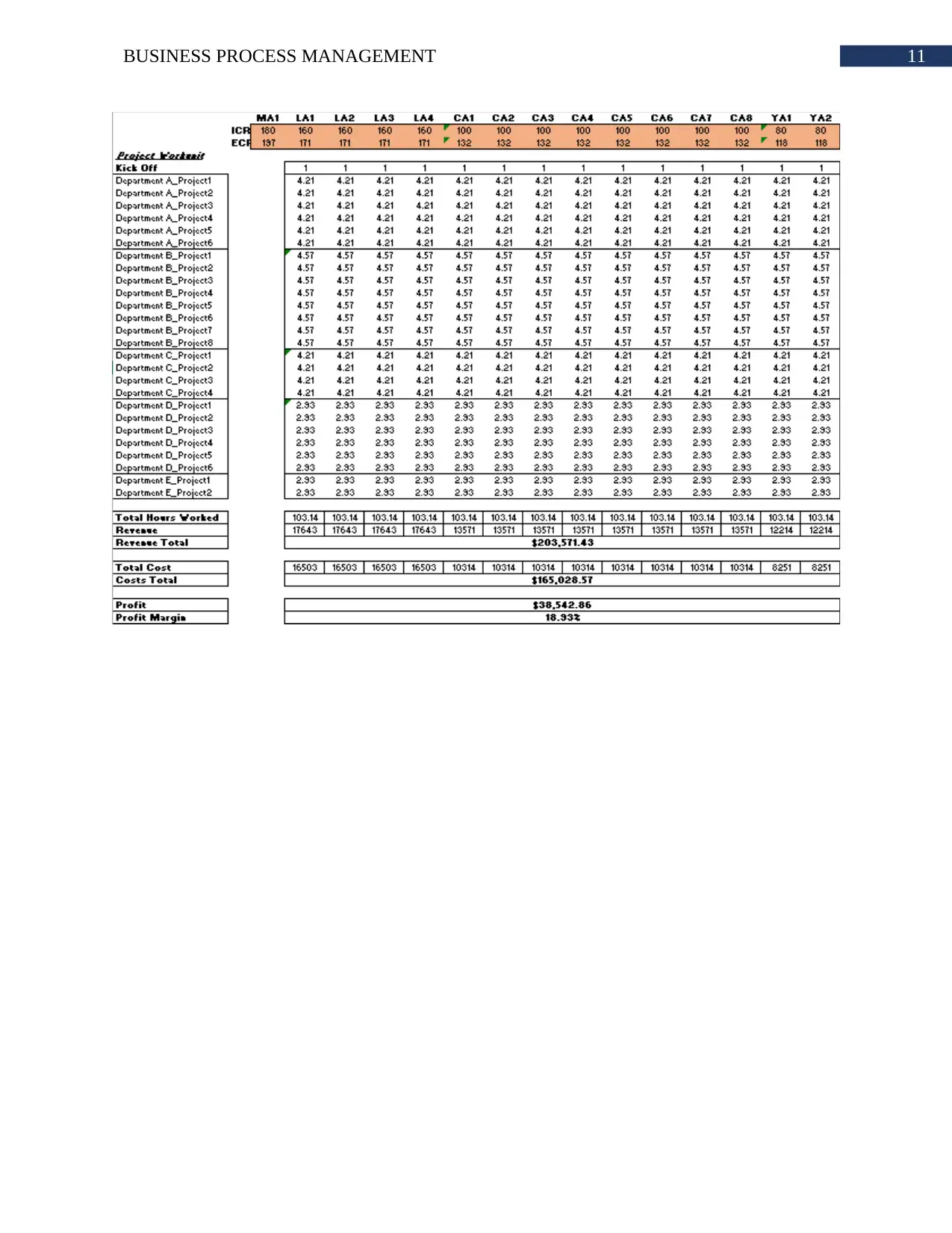
11BUSINESS PROCESS MANAGEMENT
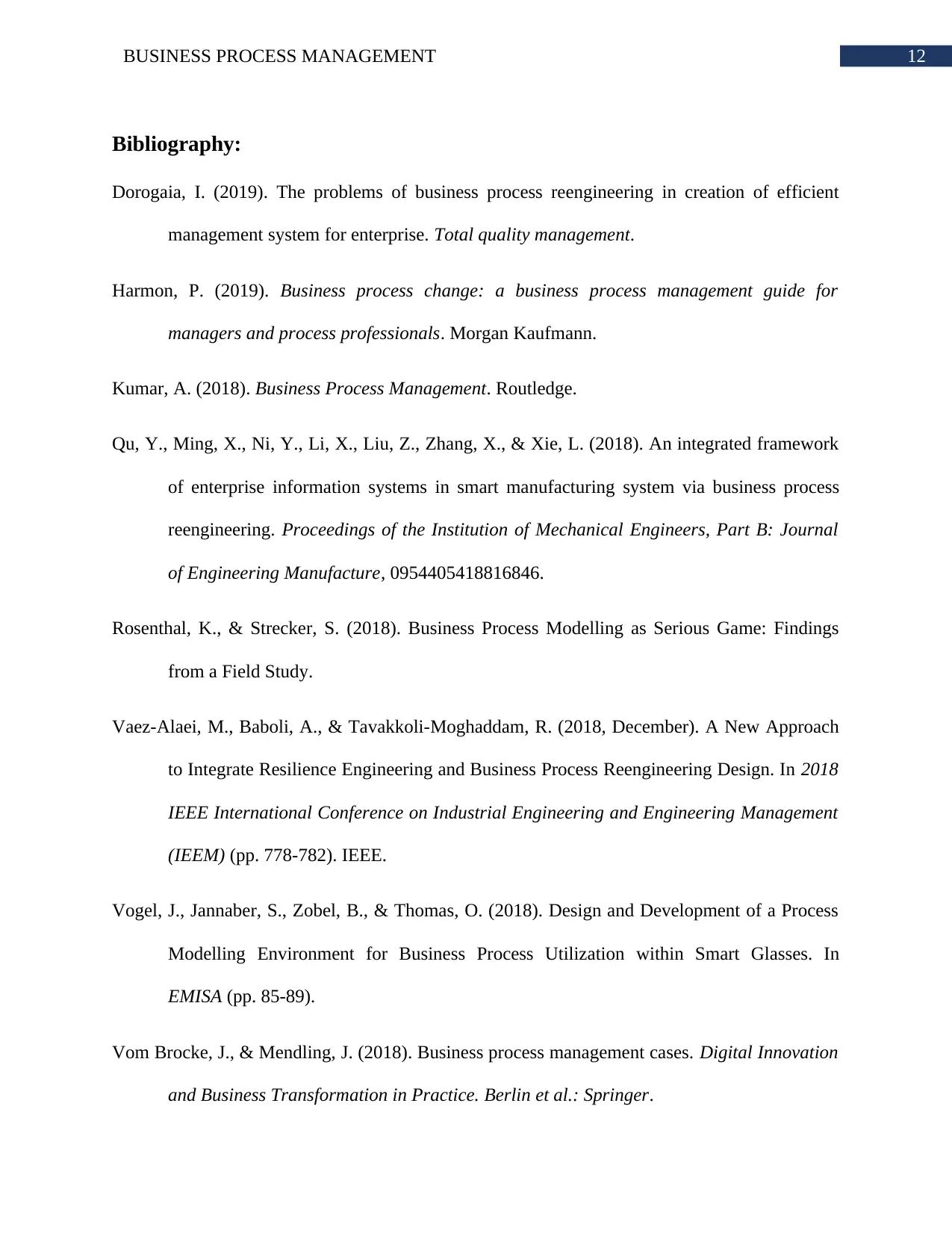
12BUSINESS PROCESS MANAGEMENT
Bibliography:
Dorogaia, I. (2019). The problems of business process reengineering in creation of efficient
management system for enterprise. Total quality management.
Harmon, P. (2019). Business process change: a business process management guide for
managers and process professionals. Morgan Kaufmann.
Kumar, A. (2018). Business Process Management. Routledge.
Qu, Y., Ming, X., Ni, Y., Li, X., Liu, Z., Zhang, X., & Xie, L. (2018). An integrated framework
of enterprise information systems in smart manufacturing system via business process
reengineering. Proceedings of the Institution of Mechanical Engineers, Part B: Journal
of Engineering Manufacture, 0954405418816846.
Rosenthal, K., & Strecker, S. (2018). Business Process Modelling as Serious Game: Findings
from a Field Study.
Vaez-Alaei, M., Baboli, A., & Tavakkoli-Moghaddam, R. (2018, December). A New Approach
to Integrate Resilience Engineering and Business Process Reengineering Design. In 2018
IEEE International Conference on Industrial Engineering and Engineering Management
(IEEM) (pp. 778-782). IEEE.
Vogel, J., Jannaber, S., Zobel, B., & Thomas, O. (2018). Design and Development of a Process
Modelling Environment for Business Process Utilization within Smart Glasses. In
EMISA (pp. 85-89).
Vom Brocke, J., & Mendling, J. (2018). Business process management cases. Digital Innovation
and Business Transformation in Practice. Berlin et al.: Springer.
Bibliography:
Dorogaia, I. (2019). The problems of business process reengineering in creation of efficient
management system for enterprise. Total quality management.
Harmon, P. (2019). Business process change: a business process management guide for
managers and process professionals. Morgan Kaufmann.
Kumar, A. (2018). Business Process Management. Routledge.
Qu, Y., Ming, X., Ni, Y., Li, X., Liu, Z., Zhang, X., & Xie, L. (2018). An integrated framework
of enterprise information systems in smart manufacturing system via business process
reengineering. Proceedings of the Institution of Mechanical Engineers, Part B: Journal
of Engineering Manufacture, 0954405418816846.
Rosenthal, K., & Strecker, S. (2018). Business Process Modelling as Serious Game: Findings
from a Field Study.
Vaez-Alaei, M., Baboli, A., & Tavakkoli-Moghaddam, R. (2018, December). A New Approach
to Integrate Resilience Engineering and Business Process Reengineering Design. In 2018
IEEE International Conference on Industrial Engineering and Engineering Management
(IEEM) (pp. 778-782). IEEE.
Vogel, J., Jannaber, S., Zobel, B., & Thomas, O. (2018). Design and Development of a Process
Modelling Environment for Business Process Utilization within Smart Glasses. In
EMISA (pp. 85-89).
Vom Brocke, J., & Mendling, J. (2018). Business process management cases. Digital Innovation
and Business Transformation in Practice. Berlin et al.: Springer.
1 out of 13
Related Documents
Your All-in-One AI-Powered Toolkit for Academic Success.
+13062052269
info@desklib.com
Available 24*7 on WhatsApp / Email
![[object Object]](/_next/static/media/star-bottom.7253800d.svg)
Unlock your academic potential
© 2024 | Zucol Services PVT LTD | All rights reserved.




